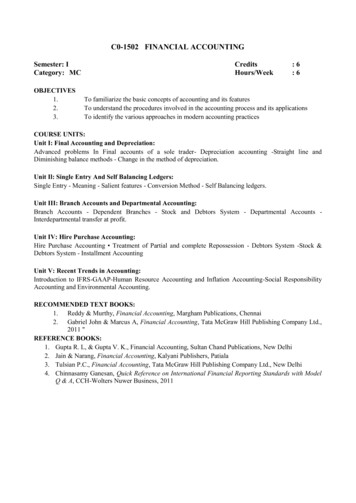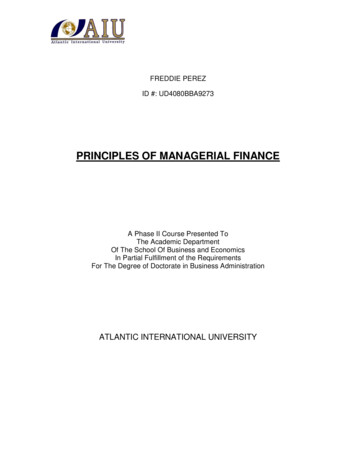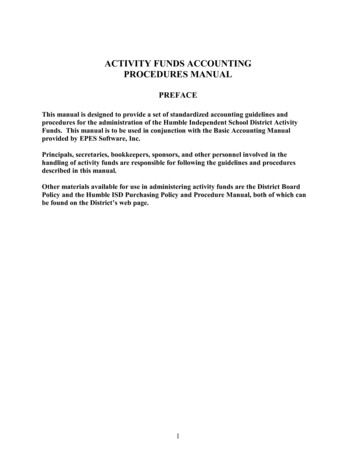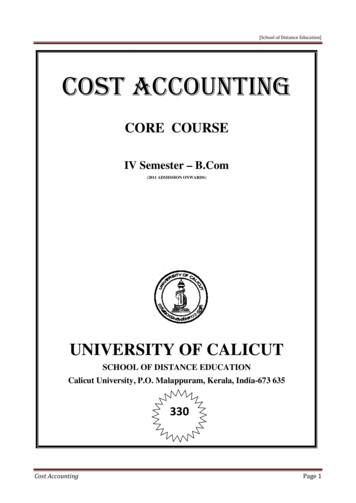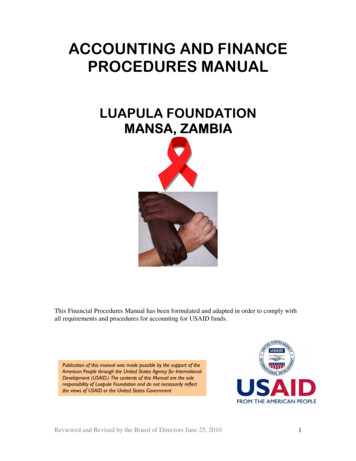
Transcription
ACCOUNTING AND FINANCEPROCEDURES MANUALLUAPULA FOUNDATIONMANSA, ZAMBIAThis Financial Procedures Manual has been formulated and adapted in order to comply withall requirements and procedures for accounting for USAID funds.Publication of this manual was made possible by the support of theAmerican People through the United States Agency for InternationalDevelopment (USAID.) The contents of this Manual are the soleresponsibility of Luapula Foundation and do not necessarily reflectthe views of USAID or the United States GovernmentReviewed and Revised by the Board of Directors June 25, 20101
ACCOUNTING AND FINANCE PROCEDURES MANUALTABLE OF CONTENTSCHAPTER 1 - INTRODUCTION TO THE PROCEDURES MANUALCHAPTER 2 - GLOSSARY OF TERMSCHAPTER 3 - ACCOUNTING POLICIESCHAPTER 4 - OVERVIEW OF THE FINANCE AND ACCOUNTING DEPT.CHAPTER 5 - RECEIPTING PROCEDURESCHAPTER 6 - PROCUREMENT PROCEDURESCHAPTER 7 - PAYMENT PROCEDURESCHAPTER 8 - STORES PROCEDURESCHAPTER 9 - CASH BOOK MAINTENANCECHAPTER 10 - GENERAL LEDGER MAINTENANCECHAPTER 11 - ACCOUNTING FOR IMPRESTCHAPTER 12 - PETTY CASH PROCEDURESCHAPTER 13 - EMPLOYEE CONTRACTS/TIMESHEETS/PAYROLLCHAPTER 14 - SALARY ADVANCES/LOANSCHAPTER 15 - BUDGETARY CONTROL PROCEDURESCHAPTER 16 - PROCEDURES FOR SAFEGUARDING FIXED ASSETS/INVCHAPTER 17 - PROCEDURES FOR CONTROL OVER LIABILITIESCHAPTER 18 - PROCEDURES FOR PERIODIC FINANCIAL REPORTINGCHAPTER 19 - RESTRICTIVE USE OF FUNDSCHAPTER 20 - RECORDS Appendices - Financial FormsAppendix ISpecimen ReceiptAppendix IIPurchase RequisitionAppendix IIIJob RequisitionAppendix IVPurchase Order pg. 20Appendix VPayment VoucherAppendix VIStock SheetAppendix VII Journal VoucherAppendix VIII Imprest Retirement FormAppendix IXPetty Cash Certificate FormAppendix XCode of EthicsLUAPULA FOUNDATIONReviewed and Revised by the Board of Directors June 25, 20102
ACCOUNTING AND FINANCE PROCEDURES MANUALCHAPTER 1 - INTRODUCTION TO THE PROCEDURES MANUALThe Luapula Foundation (LF) Accounting Manual has been produced in order to provide guidance onbest practice in accounting and financial management. Due to the size of LF and nature of itsoperations as well as those of its affiliates, simple and straightforward procedures have beendeveloped in this manual.The purpose of this manual is to document in a simplified form the Foundation’s accounting systemsand internal controls. This manual will provide guidance on how financial transactions will be treatedand ensure consistent applications of this treatment.The principles and suggested procedures in the manual reflect systems currently in operation, or beingimplemented by LF and those expected to be adopted by its affiliates.This manual has been designed to suit specifically the accounting and financial management practicesat LF, but its general principles and essential features are, however, applicable to all projects,whatever their size.This manual may not include all the desired principles and features of an accounting manual. Allthose principles and features therefore not included in this manual but applicable to member/affiliateorganisations to LF, may be read in conjunction with this manual.The manual has been prepared by taking into account GAAPs, IAS and provisions of the LFConstitution. More importantly the manual has taken into account the reporting requirements of thevarious donors funding the LF operations.As circumstances and requirements change the guide will need to be regularly reviewed and updatedto take into account new developments in the accountancy profession and especially that operations ofLF are being computerised.LUAPULA FOUNDATIONReviewed and Revised by the Board of Directors June 25, 20103
ACCOUNTING AND FINANCE PROCEDURES MANUALCHAPTER 2 - GLOSSARY OF TERMSThe terms defined below are commonly used accounting terms, most of which are used in this guide.Where necessary more detailed explanations are provided in the text.AccountA personal or impersonal record of one or more business transactions toenable a balance to be determined at any moment in time.AccountancyThe process of analysing, classifying and recording transactions andoperations in terms of time, quantity and monetary values.Accounting PeriodThe period for which final accounts are customarily prepared.Accounting SystemThe day-to-day method by which transactions are recorded and ultimatelyappear in the financial statements.AccrualThe accounting treatment of a transaction whose actual value can only beascertained after the close of an accounting period, where all or part of thetransaction relates to that accounting period, such a transaction is broughtinto books of accounts by ‘accruing’.Advice NoteNote accompanying the delivery of goods or services ordered (sometimesknown as dispatch or delivery note).Age AnalysisUsually used on a schedule of Sales Ledger balances to indicate the age ofthe balance (e.g. one month old, two months, over six months, etc)AmortisationThe writing off against profits of the loss in value of certain fixed orintangible assets where such loss is occasioned by the passage of time e.g.Leasehold property (see Depreciation).AnalyseThe process of classifying and aggregating similar types of transactionunder common headings.AssetGoods, resources and property of all kinds belonging to a company or to anindividual, which are used in the business.AuditAn examination by an independent, qualified expert (the auditor) of theaccounts and supporting records prepared by a company’s managementand the accounting principles and policies underlying them.AuditorA duly qualified person who conducts the audit.Balance (noun)The net difference between the debit and credit sides on an account.Balance (verb)To total the debits and credits in a ledger account and to enter, as abalance, the difference between the two.Balancing thebooksThe periodical closing up and adjusting of all accounts in the ledger, inorder to ascertain the profit or loss made during the period underconsideration.LUAPULA FOUNDATIONReviewed and Revised by the Board of Directors June 25, 20104
ACCOUNTING AND FINANCE PROCEDURES MANUALBank reconciliationA statement explaining the difference between the balance of an accountreported by a bank by way of a bank statement and the general ledgerbalance (see reconciliation statement).Book-KeepingThe technique of keeping accounts – of recording in a regular, concise andaccurate manner the business transactions of an entity in a set of bookskept for the purpose.Books of AccountsA set of books, which record the business transactions of a firm, company,entity etc (see bookkeeping).Booksentryofprime Books into which transactions are initially recorded according to their type.e.g. cashbook, petty cash book, Bought (Purchases) Day book, Sales DaybookBought Day BookA book of prime entry, used to list, analyse and summarise all purchasesand services obtained on credit. (See Books of prime entry)Bought LedgerA book of account, which records the personal side of all credit purchasesof goods or services.CapitalThe money supplied by the proprietors of a business in order to acquire theresources (Assets) with which to operate the business.Cash BookA book in which an account (record) is kept of all receipts and payments ofmoney, by cash or cheque.Cast (verb)To add up a column of figures.Close offTo transfer to the Profit and Loss Account in Nominal Ledger from eachaccount concerned, the amount itemised in the published Profit and LossAccount, so as to leave as balances only those, which are included on theBalance Sheet.ContraThe matching of debits with credits or the offsetting of one balance againstthe other.Credit (noun)An entry on the right hand side of a ledger account.Credit NoteDocument sent to a person, firm, etc, stating that his account is credited(reduced) with the amount stated (e.g. when goods are returned by thatperson, firm etc. or an allowance is made to that person, firm etc.)CreditorOne to whom money is owed for goods, services, etcCurrent AssetsThat group of assets in cash or near cash state (e.g. Cash, debtors, stock).Debit (Noun)An entry on the left hand side of a ledger account.Debit (Verb)To ‘debit’ an account to make an entry on the left hand side.Debit NoteDocument sent to a person, company etc. stating that his account is debited(increased) with the amount stated (e.g. as a result of price hikes, orinvoice initially undercast)LUAPULA FOUNDATIONReviewed and Revised by the Board of Directors June 25, 20105
ACCOUNTING AND FINANCE PROCEDURES MANUALDebtorOne who owes money for goods, services supplied.DepreciationThe measure of the estimated loss in money value of a fixed asset owing touse, obsolescence or passage of time (see Amortisation).DiscountAn allowance deducted from an invoice price, account etc.Double entryMethod of book-keeping in which two entries are made debit and credit foreach transaction in order to record the two aspects which every transactionhas and to provide a means of providing the entries by balancing theledgers in which each transaction is recorded.EntryThe record of a transaction in a book of account.Final AccountsThe Profit and Loss Account and Balance Sheet as agreed by the proprietorof the business.Fixed AssetAn asset which is in permanent use within a business (e.g. Land,Buildings, furniture, plant, machinery, etc)GrossA total before any deductions.Gross upThe calculation of a gross figure from a net figure by adding backdeductions.ImpersonalAccountsAccounts not dealing with persons but with other things such as ‘real orproperty accounts’ (e.g. Cash, rates, discounts, etc).Impersonal LedgerSee Nominal Ledger.Imprest SystemMethod by which a fixed amount is advanced and the expenditure for theamount at the end of the month or period reimbursed, so that the monthlyor periodic balance remains the same. Frequently used for petty cash floats.Intangible AssetsAsset, which is neither fixed nor current yet, possesses a value (e.g.Goodwill, Investment).InventoryThe Stock-in-trade and work in progress of a business.InvoiceA document showing the character, quantity, price, terms, nature ofdelivery and other particulars of goods sold or services rendered.JournalLiterally, the book containing an account of each day’s transactions.LedgerA collection of accountsThe principal book of accounts in which the entries from all the otherbooks are summarised divided into Cash Book, Bought Ledger, SalesLedger and Nominal Ledger.Ledger accountA record in the ledger showing one of the two aspects of each transactionor group of transactions (see also ‘Account’).LUAPULA FOUNDATIONReviewed and Revised by the Board of Directors June 25, 20106
ACCOUNTING AND FINANCE PROCEDURES MANUALLiabilitiesA term denoting the combined debts owed by a firm, company etc.LiquidityThe excess of cash or near cash assets over current liabilities.LodgementA payment into the bank or the credit of a specified account.MaterialityThe consideration of the significance of an amount in relation to thecontext in which it is placed. In relation to accounts, an amount is notmaterial if its effect on the accounts would not distort the overall truth andfairness of the view they give.NetThe amount of any charge or cost after all deductions has been made.Netting offSee ‘contra’Nominal AccountsAccounts for the income and expenses of a business (see ‘impersonalaccounts’)Nominal LedgersOtherwise known as the Impersonal or General Ledger. The ledger, whichcontains impersonal, accounts (see ‘impersonal accounts’).Personal AccountAn Account showing transactions with a particular person, firm orcompany as distinct from a nominal account.Petty Cash BookA book subsidiary to the Cashbook, in which are recorded all small cashpayments.PostingThe transfer of entries from the books of prime entry to their separateaccounts in the ledgers.PrepaymentA payment made in the current accounting period of which part or allrelates to a future period.Profit andAccountLoss A summary account of all revenue and expense accounts, showing as itsbalance, the profit (or loss) for the period under consideration.ProvisionsAmounts written off or retained out of profits to provide for depreciation,renewals or diminution in value of assets, or retained to provide for anyknown liability of which the amount cannot presently be determined withaccuracy.ReconciliationA statement showing the process whereby the balances of two accounts,independently written up in respect of the same transactions, which showan apparent discrepancy, are brought into agreement. The most commonreconciliation statement is that used to bring into agreement with theGeneral Ledger Bank account balance and Bank Statement balance (see“bank reconciliation”).Reconcile (verb)To ascertain the precise components of the difference between two relatedfigures produced independently of each other.RevenueIncome received from any source.Sales Day BookA book of prime entry used to list, analyse and summarize all the invoicesLUAPULA FOUNDATIONReviewed and Revised by the Board of Directors June 25, 20107
ACCOUNTING AND FINANCE PROCEDURES MANUALfor credit sales transactions.Sales LedgerA book of account, which records the personal side of all sales on credit, ofgoods or services.ScheduleA detailed list of items, on a properly headed working paper, totalled toagree with the figure that is being analysed or supported and crossreferenced.LUAPULA FOUNDATIONReviewed and Revised by the Board of Directors June 25, 20108
ACCOUNTING AND FINANCE PROCEDURES MANUALCHAPTER 3 - ACCOUNTING POLICIESAPrincipal Accounting PoliciesThe Financial statements are prepared in accordance with the historical cost convention asmodified by the inclusion of certain assets at valuation. The following is a summary of theimportant accounting policies used by Luapula Foundation.BFixed AssetsFixed assets are stated in the balance sheet at cost or valuation less accumulated depreciation.At any time, the threshold for capitalisation should be the local equivalent of US 5000,including all costs incidental to the purchase of the same asset. Any single fixed assetacquired with a value less than US 5000 should be expensed to the Income and Expenditureaccount in the year of acquisition. However, all assets less than USD5000 should be enteredin the LF inventory file for accountability.CDepreciationDepreciation is calculated on a straight-line basis to write off the cost or valuation of fixedassets over the expected useful lives at the following annual rates:BuildingsFurniture & Fittings,Equipment and vehiclesMotor vehicles-2%;20%;25%33.3%Full depreciation will be charged in the year of acquisition and no depreciation will becharged in the year of disposal. Should the policy of a donor be different from above, thedonor’s policy will take precedent over the straight line basis to write off the cost of the fixedasset.DTranslation in Foreign ExchangeAssets and liabilities denominated in foreign currencies are translated into Zambian Kwachaat the average or mid-point rates of exchange ruling at the balance sheet date. All gains andlosses arising on the translation are dealt within the receipts and payments statement in theperiod in which they arise.EInflationDue to practical difficulties of complying with International Accounting Standards number 29(IAS29) Accounting in Hyperinflatory Economies: its application has been deferred. TheZambia Institute of Chartered Accountants (ZICA), the Organisation responsible forregulations of accounting practice in the country, is currently considering a methodology,which will allow the accommodation of appropriate adjustments to financial statements inaccordance with the spirit of IAS29. Once this methodology has been finalised and should itbe appropriate, the accounting treatment used in these statements will be modified.LUAPULA FOUNDATIONReviewed and Revised by the Board of Directors June 25, 20109
ACCOUNTING AND FINANCE PROCEDURES MANUALFRecognition of IncomeGrantsGrants received for meeting operational expenses are released to the income and expenditureaccount in the year in which such grants are received. Grants received for investment inproperty, plant and equipment are treated as capital grants and amortised to the income andexpenditure account over the life of the asset concerned.CurrenciesThe financial statements are expressed in Zambian Kwacha. Transactions made in foreigncurrencies are recorded at the rate of exchange ruling at the date of the transaction. Assets andliabilities expressed in foreign currencies are translated at the rate of exchange ruling at thebalance sheet date. Profits and losses on foreign currency translation are taken to the incomeand expenditure account in the year in which they ariseGInventory/StockInventories are stated at the lower of cost and estimated net realisable value. In general, cost isdetermined on an average basis and includes transport and handling costs. Estimated netrealisable value is the price at which the inventories can be realised in the normal course ofbusiness after allowing for the costs of realisation. Provision is made for slow-moving, obsoleteand defective inventories.LUAPULA FOUNDATIONReviewed and Revised by the Board of Directors June 25, 201010
ACCOUNTING AND FINANCE PROCEDURES MANUALCHAPTER 4 - OVERVIEW OF THE FINANCE AND ACCOUNTINGDEPARTMENT4.1Financial RecordsFinancial records include all source documents (budgets, invoices, vouchers, bankstatements, credit advice, journals, cheques, receipts and any other documents whichserve as evidence of financial transactions).4.2General ResponsibilitiesThe organization requires all of its employees to abide by the foregoing standards ofethical behavior in their dealings with its suppliers, consultants, sub grantees,subcontractors, and government. Employees of the organization should not solicit forany funds, gifts or any favours from a prospective vendor, sub grantee or any otherbusiness partner. Attached as Appendix 1 to the Manual is the organizations ethicspolicy which ALL staff are required to sign on an annual basis. (Copies of the signedethics statements will be kept within personnel files).Staff are also required to report any violations of these standards to the ExecutiveDirector and Board Finance Subcommittee.The Executive Director has overall authority and oversight of all funds.4.3Finance and Accounting Responsibilities4.3.1 Finance /Operations ManagerPlease note: In absence of a designated Finance/Operations Manager, theOrganization may subcontract out with a licensed Accounting Firm for financialmanagement assistance and if these services are subcontracted, all of the dutiesspecified below will apply to the responsibilities of the subcontracted firm /individual.Primary function-Ensure that the financial system runs properly in order to process financialinformation and generate accurate reports.Ensure that internal controls are enhanced and maintained at an acceptable level,Manage risks affecting the organizations assets and make sure risks are maintained ata lower level.Ensure that financial policies, procedures and donor compliance requirements areadhered to expected standardsEnsure that internal and external financial reports are prepared and disseminatedwithin deadlinesEnsure there is enough cash on hand and vendors are paid promptlyResponsible for all aspects of cash management including:LUAPULA FOUNDATIONReviewed and Revised by the Board of Directors June 25, 201011
ACCOUNTING AND FINANCE PROCEDURES MANUAL-Monitoring receivables, billing staff and collection of debt and managing prepayments.Lead, direct, mentor/coach, appraise and supervise the other finance staffProvide budget analysis and feedback to the Executive Director on a regular basis4.3.2 Bookkeeper / Admin AssistantPrimary function-4.4Ensure that payment package is complete and accurate before processing.Ensure that charge codes are in agreement with Program Managers’ approval and theorganizations chart of accounts.Ensure that vendors/Suppliers, Staff and Sub-recipients’ cheques are prepared andpaid on time.Maintain petty cash ledger and prepare petty cash replenishment.Prepare cash receipt voucher for cash collected and deposited to bank account.Ensure that copy of cash receipt and bank deposit must be attached with the CashReceipt voucher.Ensure that the Petty cash replenishment is prepared the moment the paid cash is 90%of the cash float.Prepare cash and check deposit slip and give it to the agent for banking on a dailybasis.Cash collected from staff travel advances and other receipts must be banked withinthe next business day. .Ensure that all cash at hand must be locked in a safe overnight and on weekends.Maintain safe ledger and keep the first key of the safe.Work closely with Administrative officer on physical counting of assets, stocks andproperty.Prepare a stock count report on a monthly basisManage the asset registerPrepare cash receipt vouchers.Retrieve documents needed for AuditsEnsure that soft copy and hard copy month end closing packages are filed properlyand done within the due datesEnsure that data is posted on a daily basis, and that the financial information isprocessed accurately and reliable reports are generated timelyEnsure that internal financial reports are generated accurately and disseminatedtimely.Perform systems analysis to identify any irregularities (such as wrong posting) andpropose immediate corrective actions to the finance managerInternal controlsInternal accounting control consists of the plan of the organization, procedures andrecords to assure the reliability of financial reporting as well as safeguard the assets ofthe organization.An effective internal control structure includes a series of checks-and-balancesrequired for the appropriate recording and authorization of transactions and ensuresthat access to assets is limited to authorized personnel. Each transaction should beLUAPULA FOUNDATIONReviewed and Revised by the Board of Directors June 25, 201012
ACCOUNTING AND FINANCE PROCEDURES MANUALdivided into component tasks completed by different staff members in order toincrease the likelihood of detecting unintentional errors and prevent misappropriationof the organizations assets.As an example, the person who approves vouchers for payment should not prepare orsign cheques.The following chart includes other examples of the appropriate segregation of duties:Finance Officer who*Prepares vouchers*Prepares Cheques*Has access to Blank Cheques*Receives Cash*Is responsible for the physicalsecurity of Assets*Prepares Bank Deposits*Prepares payroll*Maintains Driver LogsShould Not*Approve Vouchers*Sign Cheques*Post Payments*Bank or deposit the cash receipts at the bank*Perform the physical inventory of Assets*Reconcile Bank Accounts*Distributes payroll payments*Monitor Fuel UsageThe following four basic tests of completeness, validity, accuracy and maintenanceshould be consistently applied to all transactions4.5CompletenessEach element of a transaction must be documented, approved and recorded.For example: A cash payment to a worker requires the signature of the worker orother proof as evidence of payment.4.6ValidityIs the disbursement made to a verifiable vendor or employee?Is there such tangible proof, such as a vendor’s receipt, purchased item, to confirmthat the item was received or the services performed?4.7AccuracyIs the amount recorded as received or disbursed correct?Are all relevant charges recorded?4.8MaintenanceAfter a payment has been approved for payment and recorded, it should be impossibleto make changes, such as addition of a zero to the amount or changing the payeename, or in deed using the same documents for other double payments. All documentsafter use must be stamped PAID to avoid re-use.LUAPULA FOUNDATIONReviewed and Revised by the Board of Directors June 25, 201013
ACCOUNTING AND FINANCE PROCEDURES MANUALClose supervision by the Finance / Operations Manager and oversight by theExecutive Director are vital to ensure that control systems are working and thatweaknesses are identified and corrected.CHAPTER 5 - RECEIPTING PROCEDURES1Objective of a Receipting SystemThe objective of a receipting system is to ensure that all funds donated/collected are fullyaccounted for in financial records and reported to the donors.2Main strategies to Achieve the ObjectiveIn order to ensure that funds are fully accounted for in financial records, the followingstrategies will be applied:a)effective control of accounting documents (receipt books, cheque books). A receiptbook will be serially numbered and have three copies. Original goes to the payer, thesecond copy is filed in Accounts department while the book copy remains as apermanent record.A receipt is a proof of payment and payer should obtain one.b)Due to the size of the organisation, Accounts Assistant will receive all monies andwill issue a receipt for all funds received and reconcile all funds received withamounts to be banked the following day at the end of each day.c)Strictly all receipts issued will be recorded and analysed in the cash books for onwardposting to the ledgers at the end of each month.d)All bank transfers (direct credits) will immediately be recorded in the cash book.Prompt recording and analysis of receipts in the cash book shows up at the earliestpoint the levels of funds received and allows spot check of cash on hand.e)All documents will be systematically filed in box files and made readily available forany prompt audit.The Accountant will be fully responsible for this receipting system and will thereforedo the bank reconciliation to separate the duties to show transparency of the system.f)All receipt books will be recorded in a Register kept by the Accountant. Only theAccountant will be responsible for the issuance of the receipt book for use. TheRegister will show:i)ii)iii)iv)v)serial numbers of each receipt book;date when receipt book received from the printer;name and signature of staff entering the new receipt books into the Register;date the receipt book issued for use; andname and signature of staff requisitioning the receipt book for use.A specimen Receipt is shown at Appendix I.Separate receipt books should be kept for each currency of funds.LUAPULA FOUNDATIONReviewed and Revised by the Board of Directors June 25, 201014
ACCOUNTING AND FINANCE PROCEDURES MANUALLUAPULA FOUNDATIONReviewed and Revised by the Board of Directors June 25, 201015
ACCOUNTING AND FINANCE PROCEDURES MANUALAppendix I – Specimen ReceiptLUAPULA FOUNDATIONCASH RECEIPTDate: / /Amount: US /KChq No.Amount in Words:Received From:Internal Department (Or Business Address):Purpose:Grant/ Account Code:Received By : Signature: Date:Verified By : Signature: Date:Payers Name : Signature: Date:LUAPULA FOUNDATIONReviewed and Revised by the Board of Directors June 25, 201016
ACCOUNTING AND FINANCE PROCEDURES MANUALCHAPTER 6 - PROCUREMENT PROCEDURES (This is a brief description ofprocurement procedures. For details, please refer to Procurement Manual)1Objective of Procurement ProceduresThe objective of a procurement procedure is to ensure that the procurement of goods andservices is and can be seen to be properly authorised and obtain best value for goods orservices and facilitate efficient accountability of funds and transparency.To facilitate efficient procurement, each division should prepare a quarterly procurementrequirement, which should be presented to the Project Director.2Strategies to Achieve the Procurement Proceduresa)The Head of the user division will fill in a Requisition form to the Project Managerrequesting for goods/ services to be purchased.b)For purchases beyond ZK 5,000,000 in value per item, quotations will be required.Quotations should not include a percentage charge of profit. All profit must bewritten into the item charges. The Project Director will liaise with the head of theuser division to exactly find out what is required and thereby go out to collectquotations from suppliers. At least three quotations are recommended fortransparency and ensuring the right quality of goods/ services is obtained.c)The Project Director will attach to the analysis of purchase alternatives to determinewhich would be the most economical and practicable procurement of the threequotations and send the details to the Accountant. The Project Director will scrutinisethe price and the quality of the goods/services and make the recommendation. It ispreferable to purchase at lowest price but with highest quality. The Accountant andthe head of the unit will scrutinise the quotations, compare them to the quarterlyprocurement requirements and verify them before they are finally sent for furtherprocessing.d)Requests for purchase up to ZK 25,000,000 will be sent to the Executive Director forapproval to purchase whereas requests for more than the above threshold will be sentto the Board for approval.e)For purchases over ZMK 15,000,000, once the purchase requisition is approved, aPurchase Order signed by the Accountant will be raised to the supplier for the supplyof goods as specified in the Purchase Order. The Purchase Order should haveconditions, which have to be fulfilled by the supplier as the goods/services aredelivered. Purchase orders for items costing less than ZMK15,000,000 may be raisedat the discretion of the accountant, or at the direction of the Executive Director. Thisis suggested particularly for items of a technical nature, or for items ordered by phonewithout direct sight of the item.f)Upon receipt of Purchase Order, the supplier will deliver the goods/services, with asigned and correct invoice, which will be inspected for quality, and quantities asspecified in the purchase order. If the goods meet the specifications on the PurchaseOrder, they will be accepted in stores and g
accounting and finance procedures manual luapula foundation reviewed and revised by the board of directors june 25, 2010 2 table of contents page chapter 1 - introduction to the procedures manual 3 chapter 2 - glossary of terms 4 chapter 3 - accounting policies 9 chapter 4 - over





